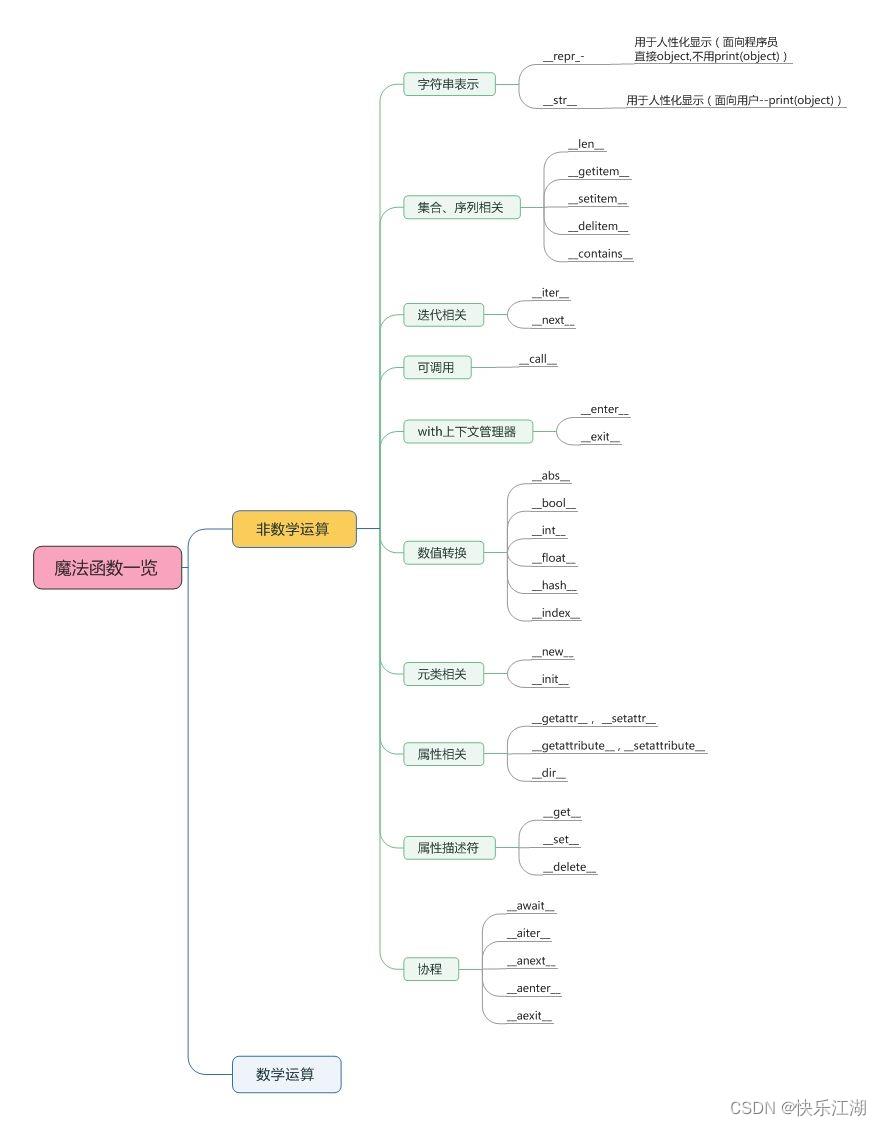:Python中的魔法函数
Posted 快乐江湖
tags:
篇首语:本文由小常识网(cha138.com)小编为大家整理,主要介绍了:Python中的魔法函数相关的知识,希望对你有一定的参考价值。
文章目录
一:什么是魔法函数
(1)魔法函数
魔法函数:在Python中,魔法函数是以__开头和结尾的函数,例如下面Python中会内置很多的魔法函数

魔法函数是Python的一种高级语法,允许你在类中自定义函数,并绑定到类的特殊方法中。我们经常使用的构造函数__init__和析构函数__del__就属于魔法函数
(2)作用
魔法函数作用:类中的魔法函数继承自object类,其作用有点像Java中的重写(例如Java中我们经常会重写toString()方法)。接下来举两个例子帮助大家理解魔法函数的作用——让类具有一些额外的功能、方便使用者理解
①:如下有一个CompanyPeople类,用于描述一个公司的员工,构造函数参数处传入一个参数列表。接着实例化对象company_people
- 如果需要遍历这个对象,那么在这种情况下就必须使用
company_people.company_people_list,而不能直接是company_people
class CompanyPeople():
def __init__(self, company_people_list):
self.company_people_list = company_people_list
company_people = CompanyPeople(["张三", "李四", "王麻子"])
for people in company_people.company_people_list:
print(people)

所以为了让这种遍历显得更加直接,我们可以使用类中的一个魔法函数__getitem__,它会在对象被迭代时发挥作用。在被迭代时会传入当前的循环变量然后进行索引
- 此时在进行遍历时可以直接写成
company_people
class CompanyPeople():
def __init__(self, company_people_list):
self.company_people_list = company_people_list
def __getitem__(self, item):
return self.company_people_list[item]
company_people = CompanyPeople(["张三", "李四", "王麻子"])
for people in company_people:
print(people)
②:如下是一个People类,有age和salary两个属性,分别表示年龄和薪资。现在我们想要让一些人进行排序,排序就会涉及大小比较,而在正常情况下,人是不能直接比较大小的,所以必须要为其制定一定的规则。这时__gt__魔法函数就派上用场了,它表示greater than,所以在进行比较时,该函数就会自动被调用
class People():
def __init__(self, age, salary):
self.age = age
self.salary = salary
def __gt__(self, other):
if self.age > other.age:
return True
else:
if self.salary > other.salary:
return True
else:
return False
people_list = [People(7, 50000)
, People(27, 1300)
, People(18, 898989)
, People(18, 4000)
, People(77, 23000)
]
people_list = sorted(people_list)
for i in people_list:
print(i.age, i.salary)
二:Python中的魔法函数
Python中的魔法函数非常多,仅靠一篇文章不可能全部介绍完毕,而且很多魔法函数必须结合具体的例子学起来才有意义。所以这里重点介绍字符串表示和集合序列相关魔法函数,剩余魔法函数在大家遇到此类问题时随时查阅学习即可

(1)字符串表示
①:__repr__:用于自定义输出实例化对象信息
- 默认情况下(也即用户不显式写出
__repr__方法时)会得到“类名+object at+内存地址”这样格式的信息 - 当显示写出
__repr__方法时,解释器会按照你所定义的格式输出实例对象信息 __repr__面向程序员
lass People1():
pass
people1 = People1()
print(people1) # 相当于执行了print(people1.repr())
print("-"*20)
class People2():
def __init__(self, name, age):
self.name = name
self.age = age
def __repr__(self):
return "People2[name=" + self.name + ", age=" + str(self.age) + "]"
people2 = People2("张三", 27)
print(people2)

②:__str__:用于返回一个对象的描述信息
__str__面向用户__repr__适用于所有环境中,__str__只是覆盖了__repr__以得到更友好的用户显示- __str__类似于Java中的
toString()方法
class People():
def __init__(self, name, age):
self.name = name
self.age = age
def __str__(self):
return "name:%s, age:%d" % (self.name, self.age)
#或者
return "name=" + self.name + ", age=" + str(self.age)
people = People("张三", 27)
print(people)

(2)集合序列相关
①:__len__:在Python中,我们经常会使用len()函数获取一个对象的长度,实际上在其内部会自动调用该对象的__len()__方法
class WordNums():
def __init__(self, *args):
self.word = args
def __len__(self):
print("调用了__len__方法")
return len(self.word)
ret = WordNums('hello', 'world', 'Python', 'encoding')
print(len(ret))

②:__getitem__:在被迭代时会传入当前的循环变量然后进行索引
class CompanyPeople():
def __init__(self, company_people_list):
self.company_people_list = company_people_list
def __getitem__(self, item):
return self.company_people_list[item]
company_people = CompanyPeople(["张三", "李四", "王麻子"])
for people in company_people:
print(people)
print(company_people[1])

③:__ setitem__: 这个方法应该以与键相关联的方式(类似字典的方式)存储值,以便之后能够使用__setitem__来获取(也即key/value)
class Test:
def __init__(self):
self.dicts = 'a':'A', 'b':'B', 'c':'D'
def __getitem__(self, item):
return self.dicts[item]
def __setitem__(self, key, value):
print("调用__setitem")
self.dicts[key] = value
test = Test();
print("test[a]=" + test['a'])
print("test[b]=" + test['b'])
print("test[c]=" + test['c'])
print("-"*20)
test['c'] = 'C'
print("test[c]=" + test['c'])

④:__ delitem__: 此方法在对象组成部分(对象必须可变)使用del语句时被调用,会删除与key相关联的值
class Test:
def __init__(self):
self.dicts = 'a':'A', 'b':'B', 'c':'D'
def __getitem__(self, item):
return self.dicts[item]
def __setitem__(self, key, value):
print("调用__setitem")
self.dicts[key] = value
def __delitem__(self, key):
print("调用__delitem")
del self.dicts[key]
test = Test();
print(test.dicts)
print("-"*20)
del test['c']
print(test.dicts)

⑤:__ contains__: 用于判断我们输入的数据是否在类里
class Test:
def __init__(self):
self.lists = [111, 222, 333, 999]
def __getitem__(self, item):
return self.lists[item]
def __contains__(self, item):
return item in self.lists
test = Test()
print(test.lists)
print(444 in test.lists)
print(999 in test.lists)

(3)迭代相关-
__iter____next__
(4)可调用
_call_
(5)with上下文管理器
__enter____exit__
(6)数制转换
__abs____bool____int____float____hash____index__
(7)元类相关
__new____init__
(8)属性相关
__getattr__、__setattr____getattribute__、__setattribute____dir__
(9)属性描述符
__get____set____delete__
(10)协程
__await____aiter____anext____aenter____aexit__
(11)数学运算类
以上是关于:Python中的魔法函数的主要内容,如果未能解决你的问题,请参考以下文章